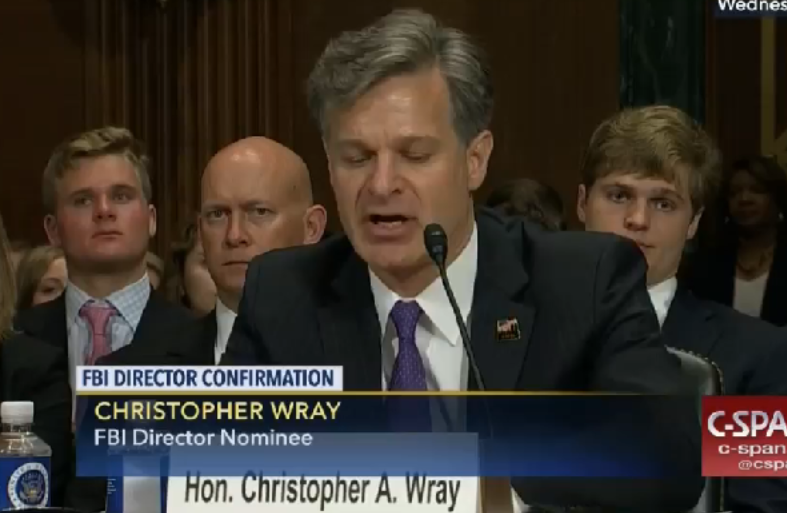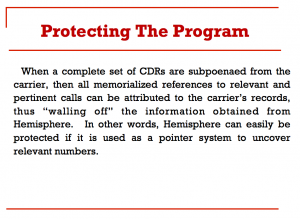Christopher Wray and the Myth Created by Parallel Construction
At the Friday Heritage Foundation Section 702 event, FBI Director Christopher Wray argued that reforming Section 702 (he suggested, illogically, making any reforms) would rebuild the wall taken down after 9/11. (Here’s the transcript, which unfortunately doesn’t include the Q&A period.)
I think back to the time that I was in government before on 9/11, right before 9/11, right after 9/11. I think about how hard dedicated men and women throughout the intelligence community worked to try to tear down the walls that had prevented us from connecting all the information that might have been able to prevent those attacks. As I said at the beginning, listening to this debate right now, watching some of the potential ideas that are being floated strikes me as eerily similar to people, well-intentioned, starting to put bricks into a wall.
There are problems with that argument (which have as much to do with our national myopia about the risks we face and how we’ve combatted them as anything else). But I’m grateful Wray made an effort to avoid the ad hominem attacks some of Section 702’s other boosters have resorted to.
Still, Wray’s response to concerns about using Section 702 in criminal prosecutions got dangerously close to that. In response to a question from David Shedd, Wray said that concerns about the topic derive from a myth. Those of us with such concerns, Wray said, are just “confused.”
There’s been a little bit of myth development in that space. When we talk about the criminal side, I think it’s important to distinguish between the tip and lead kind of scenario that I’m describing, which is where Section 702 is so important, and the prosecution end of it, where the information of any sort is being used. Section 702 has not been used for any traditional criminal case as evidence in a trial or anything like that ever, except in about 10 terrorism prosecutions. So the notion that there are criminal agents using Section 702 to make garden variety criminal cases, that’s just myth. It is not happening.
I’m reluctant to try to guess as to how people who are confused get confused. My goal is to get them straight.
To claim this is a myth, of course, Wray has to rely on a bogus number of defendants who have gotten their legally required 702 notice — ten counterterrorism cases — thereby pretending that 702 hasn’t had a key role in far, far more criminal cases, and not just in counterterrorism cases, but also counterespionage (including nation-state hacking) and counterproliferation cases. (Interestingly, defendants are only known to have gotten notice in eight cases, meaning Wray may have revealed two more where defendants got non-public notice.) Plus, as I’ve noted, FBI submitted notice about attorney-client violations to FISC in nine cases in the time since DOJ largely stopped giving defendants notice.
The numbers just don’t add up.
Which means, in significant part, what Wray calls a myth is, in reality, parallel construction, a myth of a different sort, the myth that law enforcement tells defendants about where their cases came from or why certain approaches were used with the case, the myth created by DOJ’s secret interpretations about how they deal with legally mandated FISA notice. The myth that decides Keith Gartenlaub is a counterintelligence threat because of the conversations he conducts on Skype, a PRISM provider, with his in-laws, only to scrub all mention of those Skype conversations (and, DOJ presumably maintains in its secret policies on the issue, the legal obligation to give notice) once you go to trial.
Wray goes on to blithely describe how content collected without a warrant comes to define the tips FBI Agents get, even before any evidence has been collected.
There’s the information over here, that the Agent is seeing in real time in the US. That’s the tip or the lead. And then there’s the information in the database. And it’s the connection that’s important. Let me talk about what’s in the database, first, and what isn’t. What’s in the database — that 4.3% [of the NSA’s targets] — that’s not evidence of garden variety criminal conduct. The only stuff that’s in that is information about foreigners, reasonably believed to be overseas, for foreign intelligence purposes. So that’s foreign intelligence information in there. That’s not evidence of … I don’t know, pick an example, you know, child porn, or something else. It could be very serious, but that’s not what’s in there. So the Agent over here, if he’s in national security investigator is connecting national sec–something that he thinks is national security information with foreign intelligence information. The criminal agent, who is not doing anything related to national security, he’s not looking to try to find some national security hook for his case. He’s just trying to make sure — let’s say he’s got a cigarette smuggling case — one of the things we know is that terrorist groups have used things like cigarette smuggling to finance their activities. There are cases that Department of Justice has brought over the years on that very thing. Cigarette smuggling is a crime. Well, it could be handled one way but if it turns out that cigarette smuggling that’s designed to support Hezballah, that’s different. It needs to be viewed differently. But we won’t know if we just build a wall between the Agent and the information that’s sitting right over here in the FBI database. [my emphasis]
Wray makes another error here, in claiming that “That’s not evidence of … I don’t know, pick an example, you know, child porn,” in the information FBI deems foreign intelligence information. Either that, or the government should very quickly inform the Ninth Circuit of that fact, because Keith Gartenlaub is as we speak challenging the use of a physical search FISA order to turn nine-year old child porn lying unaccessed on his hard drives into foreign intelligence information and thereafter into a criminal prosecution.
But it’s not just Gartenlaub and a traditional FISA search. Given that 702 PRISM collection obtains not only emails, but also attachments and data stored in the cloud, it will obtain a lot more than communications, including photos. Those photos may be garden variety sexy photos shared between adults (indeed, photos of that kind were also introduced in Gartenlaub’s case). But they also may be abusive photos of children. The Intelligence Community will use both kinds — as well as all the other kinds of non-email information obtained by targeting email accounts — for its foreign intelligence purposes.
It’s fairly unfortunate that, three years after FBI asked for and obtained a change in its Section 702 minimization procedures so as to be able to easily deal with child porn discovered using it, the FBI Director claimed publicly that Section 702 data doesn’t include child porn.
Of course it does.
Whether we should want the FBI to immediately prosecute child porn discovered in the name of foreign intelligence information or, first (as happened with Gartenlaub) use it to try to flip someone to become an informant, is a policy discussion we’re not having.
But the reason we’re not having that discussion is because of the other myth being told, the myths about prosecutions that have used parallel construction to hide the whys and wherefores of the case, in large part to sustain the myth Wray is telling here, that those tips and that warrantless collection have nothing to do with each other.
I appreciate Wray’s efforts to avoid dodging the key issues by attacking those of us who recognize the 702 needs reform. But what is really going on is that the myths the government tells about how intelligence is used serves to make a real policy discussion difficult (for people like me, who know the criminal cases) and impossible (for staffers and members of Congress, who don’t). Wray and others in the intelligence community have grown so accustomed to these myths (see this Bob Litt exchange for an example), that they don’t even seem to see the implications of parallel construction for our claims to due process anymore. If we’re confused about the use of 702 information in criminal proceedings, the government is confused about how metasticizing parallel construction rots the guarantees in our Constitution.
I imagine FBI would like to defer this discussion once again; pretending reformers are the ones inventing myths is a good way to do that. But it’s important, this time around, that we call the government on the myths they tell, even while they claim we’re the ones who’re confused.
Update: When I asked FBI about the discrepancy in numbers (8 versus 10), a spox emphasized that Wray said “about” 10 cases have used 702 evidence.



